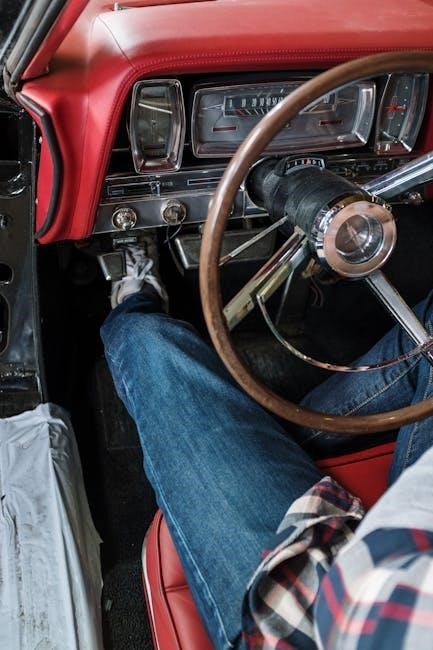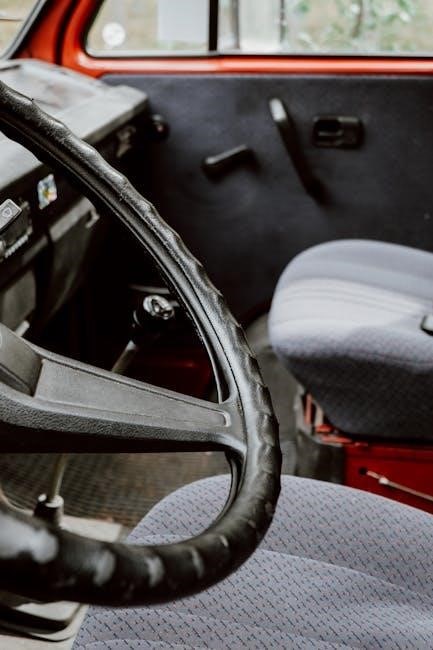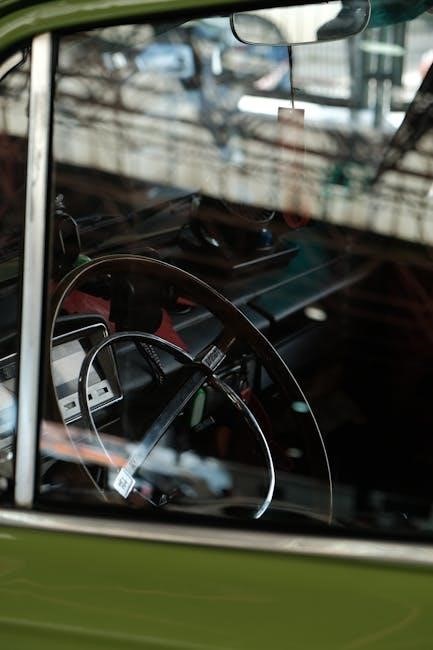Manual steering cars‚ though less common today‚ offer a unique driving experience. They require physical effort but provide direct control‚ appealing to purists. With fewer models available‚ enthusiasts cherish these vehicles for their tactile connection to the road‚ making every drive engaging and memorable.
What Are Manual Steering Cars?
Manual steering cars are vehicles that rely on the driver’s physical effort to steer‚ without the assistance of power steering systems. These cars require the driver to exert force on the steering wheel‚ especially at lower speeds‚ making them more demanding to handle. Unlike modern power-assisted systems‚ manual steering systems use purely mechanical components‚ such as gears and linkages‚ to connect the steering wheel directly to the wheels. This setup provides a more direct and tactile driving experience‚ appealing to enthusiasts who value precision and feedback. While less common today due to the prevalence of power steering‚ manual steering cars remain a niche choice for those who appreciate a more engaging and traditional driving method.
Historical Context and Evolution
Manual steering cars have a rich history dating back to the early 20th century‚ when power steering systems were nonexistent. These vehicles relied entirely on the driver’s strength and skill to navigate‚ making them more physically demanding but also more engaging. Over the years‚ manual steering evolved with improvements in steering gear design and linkage systems‚ enhancing precision and reducing effort. The mid-20th century saw the rise of power steering‚ gradually phasing out manual systems in mainstream vehicles. Despite this‚ manual steering remained popular in niche markets‚ such as classic cars and performance vehicles‚ where purists valued the tactile connection to the road. Today‚ manual steering cars are a rarity‚ cherished by enthusiasts for their authenticity and driving character.
Why Manual Steering Cars Are Still Relevant Today
Manual steering cars maintain their relevance in a world dominated by power steering due to their unique appeal and practical benefits. Enthusiasts appreciate the direct connection they offer‚ allowing for greater control and a more immersive driving experience. These vehicles are often lighter and mechanically simpler‚ making them more fuel-efficient and cost-effective in maintenance. Additionally‚ manual steering fosters a deeper bond between the driver and the road‚ promoting a more engaged and skillful driving style. In niche markets‚ such as classic cars and off-road vehicles‚ manual steering remains a preferred choice for its reliability and authenticity. This enduring charm ensures that manual steering cars continue to hold a special place in automotive culture.

The Mechanics of Manual Steering
Manual steering relies on a mechanical system where the steering wheel connects to gears and linkages‚ requiring driver effort to turn the wheels without power assistance.

How Manual Steering Works
Manual steering operates through a mechanical system where the steering wheel connects to a series of gears and linkages. When the driver turns the wheel‚ it rotates a steering column‚ which transmits the motion to a gearbox. The gearbox converts the rotational force into lateral movement‚ directing the front wheels via tie rods. This system relies on mechanical advantage‚ providing direct control without power assistance. The driver must apply physical effort‚ especially at low speeds‚ but this setup offers precise feedback and a connected driving experience. While modern systems may include some assistance‚ the core principle remains rooted in mechanical simplicity and driver input.
Components of a Manual Steering System
A manual steering system consists of several key components that work together to enable vehicle control. The steering wheel is the primary input device‚ connected to a steering column. This column transmits the driver’s rotational input to a steering gearbox‚ which converts the motion into lateral movement. The gearbox is typically a rack-and-pinion or recirculating ball type‚ depending on the vehicle design. Tie rods and steering arms then transfer this motion to the front wheels‚ directing them accordingly. Additional components like idler arms and pitman arms may be present in certain setups to enhance stability and control. This mechanical system relies on precise engineering to ensure smooth and responsive steering without the need for power assistance.
Advantages and Disadvantages of Manual Steering
Manual steering systems offer several advantages‚ including simpler mechanics‚ lower maintenance costs‚ and better fuel efficiency due to the absence of power assistance. They also provide a more direct connection to the road‚ enhancing driver feedback. However‚ the main disadvantage is the increased physical effort required‚ especially at low speeds or during tight maneuvers. This can be tiring in heavy traffic or for drivers who value convenience. Additionally‚ manual steering may lack the ease and precision of power-assisted systems‚ making it less suitable for modern vehicles prioritizing comfort. Despite these drawbacks‚ enthusiasts often appreciate the tactile experience and reliability of manual steering systems in specific driving scenarios;

Modern Applications of Manual Steering Cars
Manual steering cars remain relevant in niche markets‚ including racing‚ off-road vehicles‚ and classic car enthusiasts. They offer precise control and lightweight design‚ appealing to driving purists and specific performance needs.
Manual Steering in Racing and Performance Vehicles
Manual steering systems are highly valued in racing and performance vehicles due to their precision and direct feedback. Unlike power-assisted systems‚ manual steering provides a raw‚ unfiltered connection to the road‚ allowing drivers to anticipate and respond to every nuance. This responsiveness is critical in high-speed environments‚ where milliseconds can determine outcomes. Cars like the Toyota GR Supra‚ BMW M2‚ and Aston Martin Valour feature manual steering options‚ catering to purists who prioritize control over convenience. While physically demanding‚ manual steering delivers unparalleled handling and engagement‚ making it a cornerstone of motorsport and enthusiast driving experiences. Its lightweight and simplicity also enhance performance‚ solidifying its place in niche markets.
Manual Steering in Off-Road and Utility Vehicles
Manual steering systems are often favored in off-road and utility vehicles for their durability and simplicity. These vehicles‚ such as the Toyota Tacoma and Jeep Wrangler‚ operate in demanding environments where reliability is crucial. Manual steering eliminates the complexity and potential failures associated with power-assisted systems‚ providing a rugged and dependable solution. While it requires more physical effort‚ manual steering offers precise control‚ essential for navigating uneven terrain and tight spaces. Its mechanical simplicity also reduces maintenance needs‚ making it ideal for work or adventure in remote areas. For drivers prioritizing function over comfort‚ manual steering remains a practical choice for tough‚ no-frills applications. Its enduring presence in utility vehicles underscores its value in challenging conditions.
Manual Steering in Classic and Vintage Cars
Manual steering is a defining feature of classic and vintage cars‚ embodying the essence of traditional driving. Vehicles like the Aston Martin Valour and Morgan Plus Four retain this characteristic‚ offering a nostalgic experience. The absence of power assistance requires skill and effort‚ fostering a deeper connection between driver and car. Enthusiasts prize these cars for their authenticity‚ as manual steering enhances the tactile nature of driving. While less convenient for modern roads‚ this feature is cherished for its historical significance and the unique driving satisfaction it provides. Classic car collectors often seek models with manual steering to preserve the original driving feel‚ making it a cornerstone of automotive heritage.
Driving Techniques for Manual Steering Cars
Manual steering demands precise techniques‚ ensuring smooth control and responsiveness‚ essential for mastering the art of driving with passion and precision.
Mastering the Art of Manual Steering
Manual steering requires skill and practice to handle effectively. It demands a strong connection between the driver and the vehicle‚ as every turn must be deliberate and precise. Smooth‚ controlled movements are essential to maintain stability‚ especially at higher speeds. Drivers must develop muscle memory to navigate corners seamlessly and adapt to varying road conditions. The lack of power assistance means physical effort is necessary‚ particularly in tight spaces or during slow maneuvers. Over time‚ mastering manual steering becomes second nature‚ offering a more engaging and rewarding driving experience. It fosters a deeper understanding of the vehicle’s dynamics and enhances overall control.
Tips for Improving Control and Precision
Improving control and precision in manual steering cars involves a combination of technique and practice. Maintaining a firm yet gentle grip on the steering wheel is crucial‚ allowing for subtle adjustments. Drivers should focus on smooth‚ gradual turns rather than abrupt movements‚ which can destabilize the vehicle. Proper hand positioning‚ typically at 3 o’clock and 9 o’clock‚ enhances control and reduces fatigue. Additionally‚ understanding the vehicle’s weight distribution and suspension dynamics helps in anticipating handling characteristics. Regular practice in controlled environments‚ such as empty parking lots‚ can build muscle memory and improve responsiveness. Over time‚ these techniques refine driving skills‚ leading to greater confidence and precision behind the wheel.
Manual steering cars‚ though rare‚ offer a unique driving connection. Their decline highlights a shift toward convenience‚ yet enthusiasts cherish the tactile experience they provide.
The Future of Manual Steering Cars
The future of manual steering cars appears uncertain as automation dominates the automotive industry. With advancements in autonomous driving and electric vehicles‚ the demand for manual steering systems continues to decline. Many manufacturers are phasing out manual options to focus on more technologically advanced solutions. However‚ niche markets‚ such as classic car enthusiasts and performance driving communities‚ may keep manual steering alive. While not as prevalent‚ manual steering cars will likely remain a choice for those valuing traditional driving experiences. The shift toward convenience and technology may limit their availability‚ but they won’t disappear entirely.

Final Thoughts on the Importance of Manual Steering
Manual steering cars hold a special place in automotive history‚ offering a raw‚ unfiltered driving experience. Despite the rise of power steering and autonomous technologies‚ manual steering remains a symbol of traditional craftsmanship and driver engagement. It fosters a deeper connection between the driver and the vehicle‚ requiring skill and precision. For enthusiasts‚ this tangible link to the road is irreplaceable. While modern advancements improve comfort and convenience‚ manual steering preserves the essence of driving as an art form. Its relevance lies in the joy it brings to those who appreciate the simplicity and authenticity of classic motoring experiences.
